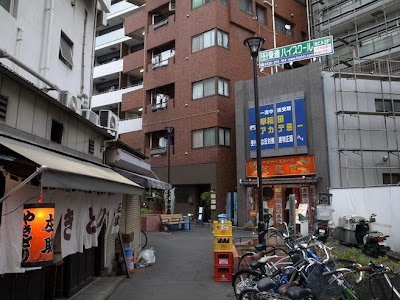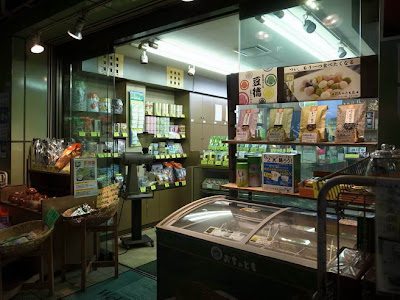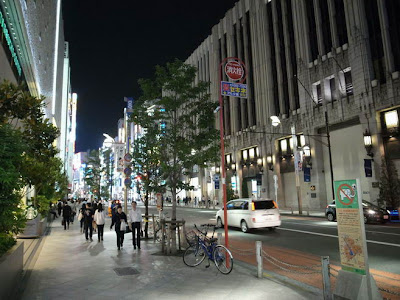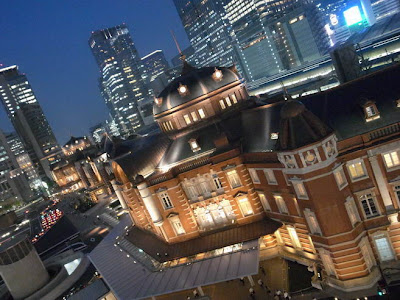(Above) - Jiyugaoka Station / 自由が丘駅
(Above) - A small island of green plants in a sea of asphalt in central Tokyo.
Bicycle Parking
-----
Park on the Toyoko Line.
-----
(Above) - Multi-use building on the Toyoko Line that is scheduled to be torn down in a year to two (according to a tenant of the building I stoke to).
Naturally it's generally a good thing for a city to rebuild and modernize, but since Tokyo is especially speedy in rebuilding, there are not many old buildings left. So, when I see old structures like this, I appreciate them for their rarity and connection to the past.
(Below) - I'm not sure what this marker is exactly, but it's dated April 1938.
(Below) - Tokyo didn't use to have a graffiti problem, but these days, somebody (how many?) has been going around spray-painting scribble-marks all over the city - even on the inside of buildings! (See right side of elevator.) Artistic graffiti on obscure outside walls is one thing, but these hideously ugly scribble marks are basically just a form of vandalism. I guess someone really hates Tokyo? Why else would you spray-paint hideous scribble marks all over everything?
-----
Along the Toyoko Line.
Along the Toyoko Line.
(Below) - Evening shotengai shopping street.
-----
(Below) - Jiyugaoka / 自由が丘
-----
Back ally in central Tokyo
Back ally in central Tokyo
Back ally in central Tokyo
(Below) - Construction project in Ginza. They dig down about three stories these days when they construct buildings around 20-30 stories high.(Below) - Rusting steel is a common sight in Tokyo these days. It appears to have been decided that it's better to just let current steel things rust, and then (eventually) replace them with something that doesn't need to be painted...? I'm not sure, but what I do know is there didn't use to be so much rust in the city.
-----
Atrium of the JP Tower, showing the back of the remaining section of the 1931 Tokyo Central Post Office - now full of restaurants and retail shops. (A section of the building to the left contains a post office - smaller than before, but with the original pillars, etc.)
(Below) - Jiyugaoka Station / 自由が丘駅
(Below) - Shinjuku / 新宿
(Below) - Increasingly rare, there is still some farmland within Tokyo.
Kanda Station under construction / 工事中の神田駅
(Below) - I still don't know that these are, but they came out of a building that used to be a hotel. I was thinking they might be something from the air system, but as they have what looks like dried dirt on the inside surfaces, I wonder if they were something within water pipes? Either way, the only purpose I can imagine for them is as noise suppressors... or to guide the direction of air before it enters a room? But they don't look as though they were adjustable....
-----
In the peak heat of the summer, I was looking forward to autumn, but now that September is here (it's September 1st as I write this), suddenly I realize that as the temperatures drop and winter approaches, I will soon be missing the green of summer.
-----
(Above) - I don't know what this building is - but it's one of the oldest in the area in which it sits (not far from Tokyo Station), and it has a slightly mysterious air about it....
(Above) - Nihonbashi Side Street / 日本橋横道
(Below) - Temple in central Tokyo
-----
Hamamatsucho / 浜松町
Hamamatsucho Station / 浜松町駅
Hamamatsucho Station / 浜松町駅
(Below) - Riveted steel rail bridge. This type of bridge makes the coolest noises when trains go by overhead! Modern design makes everything quiet, but I think it's actually kind of a bad thing when things are too quiet. Machinery and large moving objects should make some noise - which conveys their existence as machinery to the bipeds in the vicinity. When things are overly quiet, people lose the concept of everything that has gone into machinery, structures, etc. and perceive daily encounters with elevators and other complicated equipment in the same way they perceive natural forces like the wind, the sun rising and falling, etc.... Stand under a bridge like this though, and really listen to the noises generated by the trains going overhead and - if you listen carefully enough and think hard enough - you get a history lesson and strong sense of decades of time and the changing flow of people who walked under the bridge - each of them getting - consciously or unconsciously - that same history lesson. Thinking of that, I would love to jump back in time and experience the bridge when it was new. Presumably the feeling would be somewhat different then.
(Below) - Yurakucho still has a lot of atmosphere to it, but the historical resonance is being weakened as ever more of the atmospheric old things are destroyed and glistening new things put in their place. I've always thought that one of the best aspects to Tokyo is how old and new are mixed together throughout the city, but increasingly there is only new, and I wonder what sort of city Tokyo will become if everything old is eradicated. Many people feel this way, and their voices are what saved the old Tokyo Station building, and (part of) the former Central Post Office, so maybe the value of having some old things within the city will gain more respect?
(Below) - And speaking of the old Tokyo Station building - here it is. I think they probably did exactly what needed to be done to the building, but it was half renovated and half rebuilt - and the feeling of the building is exactly that. You get a sense of something old here and there, and certainly the external appearance is authentic and very cool, but much of it is also squeaky new and feels like a squeaky new building. Not a complaint - just a comment. For the structure to be used for decades to come, it had to be extensively reworked, but much of its atmosphere was lost in the renovation/reconstruction.
(Below) - A postcard of Tokyo Station from some time before WW-II (which is easy to tell, as pre-war postcards have the Japanese written from right to left, and post-war postcards have the Japanese written from left to right - not to mention, in this case, that the building was fairly extensively damaged in WW-II bombing of Tokyo). Incidentally, old color postcards (from the 1920's, 1930's, etc.) were generally hand-colored black-and-white photos, but the coloring was so good, many of them look like authentic color photographs.
(Below) - Vertical view taken in the same direction as the above picture. Stepping back from the scene - looking at it from above (as I was when I took this), it a picture of developed city perfection. But if you spend any time walking along the many wide roads full of internal combustion machinery, and compare that to streets designed for pedestrians first and foremost, you have to hate automobiles. And these are the words of a person who loves machines and loves to drive... but I think frivolous use of noxious fume generating machinery should be illegal within crowded mega-cities (out in the countryside is a different issue of course). Delivery vehicles, ambulances, fire trucks, etc., naturally! Frivolous personal use instead of utilizing the train system? No. It should be illegal. What does this have to do with this picture? In some old photos I've seen of Tokyo Station back when it was new, the area was obviously geared towards pedestrians, and now the area is much more geared towards internal combustion machinery. This, I believe, is more devolution than evolution. Human beings should be given priority over the machines.
Copyright 2013 by Lyle 宏 Saxon
Lyle (Hiroshi) Saxon
http://www5d.biglobe.ne.jp/~LLLtrs/
http://youtube.com/lylehsaxon
http://lylehsaxon.blogspot.jp/
http://lookback1997.blogspot.jp/
http://tokyoht.blogspot.jp/














































No comments:
Post a Comment